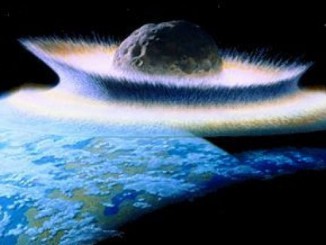
Two years ago, on 15th February 2013, the biggest mid-air asteroid explosion since the Tunguska Event of 1908 sent shock waves racing across the entire world as we were given a startling reminder of the danger from space.
The morning of the explosion started like any other bitterly cold day in the industrial city of Chelyabinsk, a Russian conurbation in western Siberia. Graced by clear blue skies, the populace were setting about their business. Many were in their cars, heading to work or school, as the clock-hand ticked onto 9:20am local time (0300 UT).
Their in-car cameras saw it before the people did. In the eastern sky, close to the early morning Sun, a light appeared, streaking westwards. In just 16 seconds the meteor descended from 90 kilometres up to an altitude of around 15 kilometres. Between 32 and 47 kilometres high it began to brighten, flaring at its most stunning at about 23 kilometres altitude when it outshone the morning sunlight for a moment, casting shadows as the object broke into several fragments. Then as quickly as it had arrived, it faded away, leaving a thick trail of billowing white smoke high overhead.
People pulled their cars over to the side of the road, stood in the street or moved to stare out of their windows in amazement at what had just taken place silently over head. Almost three minutes later, the shock wave hit.
Windows were blown in as buildings shook and people inside were thrown across rooms. Car alarms everywhere began to wail and the factory roof collapsed. As ambulances rushed to provide medical aid to the 1,491 injured by flying glass, the entire city fell into a state of shock, a shock that would soon reverberate around the world.
Quickly, those in-car camera videos were posted on YouTube for everyone to witness. It became apparent that this was a meteor, a chunk of rocky space debris that had entered our atmosphere from the east over Siberia and exploded at a height of 23 kilometres above the ground. The enormous quantity of videos showing the meteor from almost every conceivable angle was unprecedented, making it the most observed meteor in history and giving scientists vital clues in their quest to uncover what the meteor was and where it had originated. Searches in the surrounding snowy Chelyabinsk Oblast region uncovered fragments of the meteor; small rocky pellets that were swiftly whisked away for analysis at the Urals Federal University in Yekaterinburg. Enough meteoritic debris was found to convince scientists that the meteor had been a stony asteroid, termed a chondrite, containing ten percent iron-nickel metal. Such meteorites are fairly common. More interesting was the discovery that inside the various rock fragments were shock veins of melted minerals that were formed not by the intensity of the entry into Earth’s atmosphere, but by another event long ago. Scientists infer their presence to be down to the trauma of an impact between two asteroids, a collision that chipped off the smaller asteroid that ultimately disintegrated in Earth’s atmosphere.
The many videos documenting the meteor allowed scientists to accurately triangulate its approach trajectory and trace its path backwards to find out exactly where it came from. Jorge Zuluaga and Ignacio Ferrin of Universidad de Antioquia, Colombia, were the first to run calculations that point to the asteroid having originated from a family of space rocks known as the Apollos. Apollo asteroids, named after their prototype asteroid (1862) Apollo, are Earth-crossers. They spend most of their time further from the Sun than Earth, but their elliptical orbits bring them for a short time inside Earth’s orbit, crossing our path on the way in and the way out. It seems that the Chelyabinsk asteroid was on the way out when it found our planet looming in front of it. NASA estimated the asteroid to be between 17 and 20 metres in size, with a mass of 11,000 tonnes, which entered the atmosphere at 18.6 kilometres per second. When it detonated it released a total of 440 kilotons of energy – approximately thirty times the destructive power of the ‘Little Boy’ nuclear bomb dropped on Hiroshima in 1945 – but only about 90 kilotons of this was represented by the light and heat of the dazzling fireball as it streaked through the morning sky. The rest of the energy was found in the powerful blast wave that shook Chelyabinsk mere minutes later.
The saving grace seems to be that the meteor exploded so high up. To get an indication of what might have happened had the meteor exploded in an airburst at a much lower atmosphere, one only has to examine another meteor event that shook Siberia just over a century ago. On 30 June 1908, what is suspected to have been a small asteroid or fragment of a comet entering Earth’s atmosphere over the Tunguska region exploded at an altitude of between five and ten kilometres. The blast is estimated to have carried a destructive energy of up to 30 megatons and wreaked devastation across 2,150 square kilometres, flattening 80 million trees in the process. It is fortunate that the Tunguska Event occurred in the middle of nowhere – had it exploded over an inhabited region it could have destroyed a city, with the loss of hundreds of thousands of lives. Indeed, had it arrived six hours earlier, it could have hit London. Similarly, Chelyabinsk is at the same latitude as Newcastle; had it arrived at a slightly different time, the airburst could have been rattling windows on the Tyne instead.
The Tunguska Event was several orders of magnitude more powerful than the meteor over Chelyabinsk and had it hit a populated region the damage would have been far more severe than shattered windows. Chelyabinsk was the biggest such meteor event since Tunguska. This time we got lucky. What happens next time?
Further reading: How to prevent another Chelyabinsk



